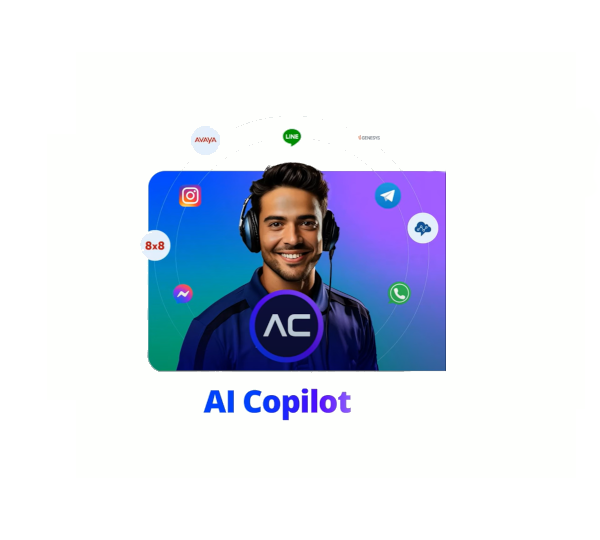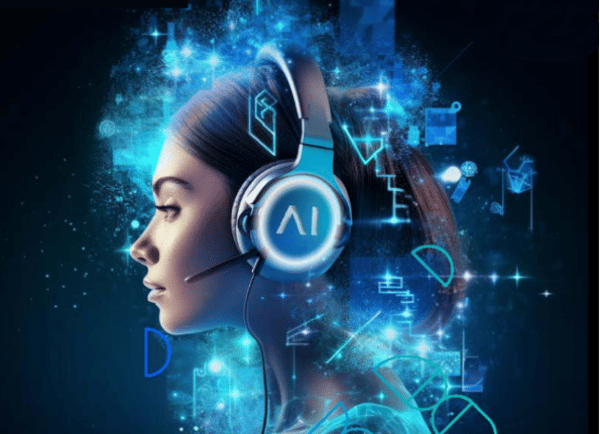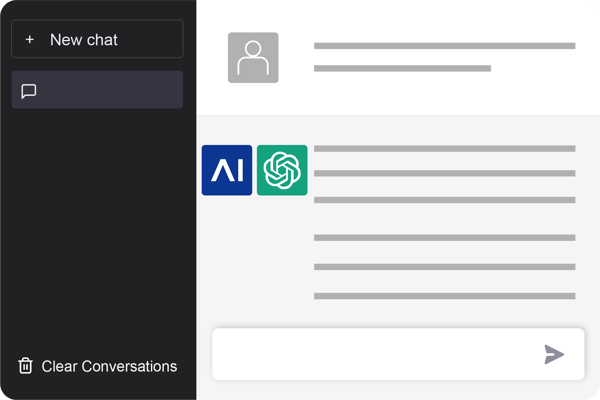Call centers have always capitalized on new-age technologies to improve their operations and services, ranging from innovative routing systems to IVR. Now, it is time for a shift to Artificial Intelligence.
As per a recent survey, inbound traffic to AI-powered or automated call assistants rose by 40% in the February-April 2020 alone. Does the inevitable increase in automated processes spell a threat to human agents?
In this blog, we are going to explore the utility of AI in call centers, its shortcomings, and the scope for a groundbreaking human-AI partnership.
How has AI Enhanced Call Centers?
In the early 2000s, contact centers saw call center automation as a way to reduce costs and time. Today, businesses mention caller experience as the number one reason for investing in call center automation, and cost reduction as the second.
The following are some AI use-cases that are enhancing call center experience for callers today:
-
Conversational IVR: On a standard IVR (Interactive Voice Response) callers communicate their queries by either entering text/numbers or by speaking on the phone (possible with ASR or Automatic Speech Recognition). But, these options come with certain issues. For example, ASRs are limited and are only equipped to answer very specific queries without the ability to recognize context. Another issue is that regional accents are out of the ambit of this technology. Even if agents are assigned specific types of calls, the prevalent system of callers having to navigate a series of menus and staying on hold till the right agent is available is not ideal.
With its abilities of dealing with subjective questions quicker, cross-referencing data across the system, and providing real-time information to live agents, Conversational AI can save a lot of time and effort.
Moreover, with the combination of Conversational AI, Natural Language Processing, and Machine Learning, simple inquiries such as “Tell me my account balance” can be addressed without involving a human agent or navigating through multiple layers of menus. This makes the system more caller-friendly and leaves more time for human agents to deal with larger issues.
-
Chatbots: Traditional or rule-based chatbots follow a preset series of steps, similar to an IVR, before they finally route callers to live agents in case of a complex, subjective problem. Conversational AI-powered chatbots, on the other hand, are not only the better choice in terms of efficiency, but also the preferred choice of the modern audience. These futuristic chatbots promise shorter wait times, better support to human agents, and superior customer experiences. That is exactly what contact centers need in order to cater to an audience in which more than half of the people prefer chat over calling customer care.
-
Analytics: AI voice analytics can gather and interpret data from voice interactions and use sentiment analysis to provide qualitative insights. AI can help systems gauge tone of voice, context, and other aspects. This information can help organizations predict caller behavior better, set more customized goals for live agents, and train live agents better.
-
Big Data management: AI has to go hand-in-hand with Big Data for organizations to make good use of it. Big Data is too complex that it requires humans to first organize, then interpret and analyze, before deriving any actionable insights. If AI synthesizes data from the moment it comes in, AI can consume, learn, and comprehend it in much less time.
Reasons for the growing penetration of AI in call centers
There are several market-related reasons too, for the growing preference for AI technology in call centers. Some of the key reasons are:
-
Increase in demand: Thanks to the speed and efficiency of chatbots, end-users are increasingly showing an inclination towards them. As per a Salesforce study, 69% of consumers prefer chatbots.
-
Growing competition: Organizations that adopt AI faster will be able to enhance operations faster and stay ahead of the curve with more efficient practices.
-
Diversification of platforms: Chatbots allow organizations to integrate their services with platforms such as WhatsApp and Facebook Messenger, providing end-users with more options to connect with customer support and additional services.
-
Remote working issues: With sudden changes such as offices being locked down and employees working remotely, 2020 is witnessing an increasing reliance on AI agents.
-
Automated data collection: The use of AI for communication also provides scope for automated data collection, which can give teams a chance to focus more on analysis, optimization, and improvements.
Why is AI indispensable to call centers?
The following inherent qualities of AI make it a must for contact centers to adopt it and keep up with the times.
-
As opposed to live agents, AI agents can be available round the clock. Callers do not need to wait for agents to be available during working hours.
-
AI systems can gather knowledge and imbibe and improve practices on their own over time. They don’t need as much constant attention as human agents do, and can be counted on to retain everything they are taught.
-
AI systems can be connected to enterprise systems, giving it knowledgeable and transactional attributes in no time.
-
With AI handling a sizable part of the problem-solving process, employee training costs can be reduced.
-
Organizations can focus better on a smaller set of specific skills such as how to handle emotional callers, how to solve unique problems, etc. to look for while hiring and training agents.
-
Organizations can save costs on infrastructure, manpower, and maintenance with a significant part of the workload being shared by AI technology.
-
A lot of time spent by human agents on accessing and analyzing data, calls, and queries will be saved with AI’s real-time data access and analysis features.
-
Conversational AI can be streamlined across platforms, which means that callers can seamlessly access help and share data with mobile apps, social media, phone calls, text messaging, or any other platform. When required, AI can also pass on the information collected from the caller to a live agent who can directly address the complex problem.
-
Routine tasks that might suffer due to human oversight can be done with precision by AI.
-
Ultimately, AI has been made to improve processes with the help of humans. AI agents can be reliable partners to human agents, available at any hour of the day or night.
Why AI will not completely replace call center agents?
Does the inevitable growth of call center AI mean a threat to the jobs of contact center agents? Not at all. An AI can only get as close as ‘human-like’. It is not a ‘turn it on and forget it’ system, as it lacks critical aspects of human interaction.
-
Emotions: AI is intelligent and ingenious, but not empathetic. Callers are used to emotional exchanges with human agents and being pacified by them. Denying them comfort would only decrease satisfaction and become counter-productive.
- Personal touch: As per a 2018 Forester study, 83% of callers said that they would prefer to talk to a human agent since they understand caller needs better. AI hasn’t evolved enough to be able to emulate a human voice completely, and it cannot learn evolving lingo and jargon on its own. That is why we need to focus more on AI call routing and making the lives of agents easier (more about this below).
-
The need for entertainment and humor: Humor is not AI’s strong suit yet. Only a human agent can infuse humor and light-heartedness into a conversation when required. The candor and candidness of a human agent shape a brand’s personality, as for the caller, it is like talking to the brand itself.
-
AI isn’t advanced enough to work unmanned yet: Setting up call center AI systems and implementing them is still a human skill. No matter how developed AI is, it surely cannot think with its own mind or pose a threat to us.
All of this brings us back to one introspective question — why did we develop machines? To aid us, boost our efficiency, and to make our lives better. That is exactly where contact center AI is headed right now.
AI and agents combo is the contact center future
Consider the case of Mercedes-Benz's Stuttgart plant where humans lift heavy parts and place them with the help of Cobot (collaborative robot) arms, an extension of their own bodies. Similarly, many major banks in the world use AI to enhance the accuracy of fraud detection by handling a huge part of the workload and leaving only the more complex cases flagged for humans.
In most industries, AI is working hand-in-hand with humans to advance processes and boost efficiency. In call centers alike, this partnership can be achieved with processes such as:
1. Intelligent call routing
The goal of call routing is to optimize human resources and connect the right caller to the right agent. AI-based routing works with two kinds of data to achieve these two objectives.
-
Caller data: Previous inquiries, priority caller status, personality based on database and external sources like social media.
-
Agent data: Agent’s personality, skills, and experience.
Based on this data, it routes incoming calls to the agent who is best suited to the caller’s personality and current need. In case the best-suited agent isn’t available, AI call routing can also make critical decisions with regards to whether it should make the caller wait or assign them to the next best agent.
The major advantages of intelligent call routing are:
- Callers do not have to repeat their concerns again and again to different agents if a single one can answer all of their questions at once. Not only that, but AI can store and process information discussed during the call and correctly brief the next agent when necessary.
- With AI call routing, agents can attend to and close calls at one go and improve the efficiency of their work.
- Coupled with Conversational AI, AI call routing can save a lot of time spent by the agents attending to minor issues, thus helping them focus on major challenges.
2. Live call guidance
There are two ways in which AI can provide live call assistance to human agents during calls.-
RTSA (Real-time speech analysis) listens to calls passively, applies speech recognition and analysis, evaluates specific factors like stress levels, speech clarity, etc. and suggests improvements to the human agent in real-time. This is much more efficient than human managers listening to recorded calls later and providing subjective feedback.
-
With its Big Data-crunching abilities we discussed earlier, AI can not only present quantitative data to live agents while they are on calls, but also make accurate predictions about what callers want, when they want it, how much time they will spend looking for it, etc. This combination of quantitative and qualitative analysis can then be interpreted quickly by a human agent to suggest the best plan of action for a caller.
3. Mutual skill development
The trick is to help humans improve with AI’s data capabilities and help AI improve by making it learn specific qualitative human attributes.
-
With the time saved by AI-based routing and AI’s quick processing of routine queries, human agents can be trained better.
-
Feedback data received from callers and analyzed by AI can also enhance training modules.
How can call centers make the most of the Human and AI partnership?
AI is far from replacing human agents, but it’s certainly closer to aiding and upgrading them. There are some crucial practices to keep in mind while leveraging AI for enhancing caller care.
Data quality: As the creators and owners of AI, it is up to us to source and feed it good quality data. The more inaccurate and incomplete our data is, the less helpful AI analysis and insights would be.
For greater accuracy, CRM (Customer Relationship Management) integration is necessary. Data on callers, their past interactions, purchase history, etc. coupled with intelligent routing would make for an ideal scenario. It will help human agents to match caller expectations with sales objectives and offer optimal suggestions to callers.
Capitalizing on context: Data from AI systems improves context assimilation for live agents and saves callers the trouble of repeating their complaints. Chatbots that do not capture context are a prime grievance for callers. Organizations must endeavor to improve context-based understanding for both AI and human agents in order to create fruitful caller journeys.
Agent profiling: Contact centers aren’t all about callers. Agents also need to be satisfied and encouraged in order to keep processes running smoothly. Profiling of agents as per their temperaments, skills, ability to handle certain types of callers, etc. can help intelligent call routing systems to do their jobs better.
Streamlining: There should be an organized loop of data right from the tracking of call history to resolution. Response time, abandonment rate, handling time, etc. can help humans to work on improving processes in parallel. Streamlining leads to better insights and better actionable measures.
The future of your contact center
Contrary to popular beliefs, AI is not here to become a competitor to call center agents but to add to their efficiency and work cohesively with them. In this regard, the entire human-AI partnership proposition can be summed up in the following key points.
-
Investment in AI is no more an option but a necessity for faster, more efficient call centers.
-
AI is not a competition but a pathway to greater efficiency for human agents.
-
When humans and AI work seamlessly together, caller journeys will become more enhanced, meaning an overall better Customer Experience (CX).
-
Working with AI is a skill that human agents must be trained in.
-
Organizations ought to study AI and constantly work on using it in innovative ways to achieve the satisfaction of contact center employees, callers, as well as sales and marketing objectives.
Interested in learning more about Conversational AI? We have recently published a Whitepaper containing all the information you need to bring Conversational AI into your contact center. Download "Why Conversational AI is the Customer Service of Tomorrow" now!

.png?width=60&height=60&name=AI%20Copilot%20logo%20(mega%20menu).png)




.png?width=600&height=600&name=Knowledge%20AI%20Feature%20image%20(2).png)













